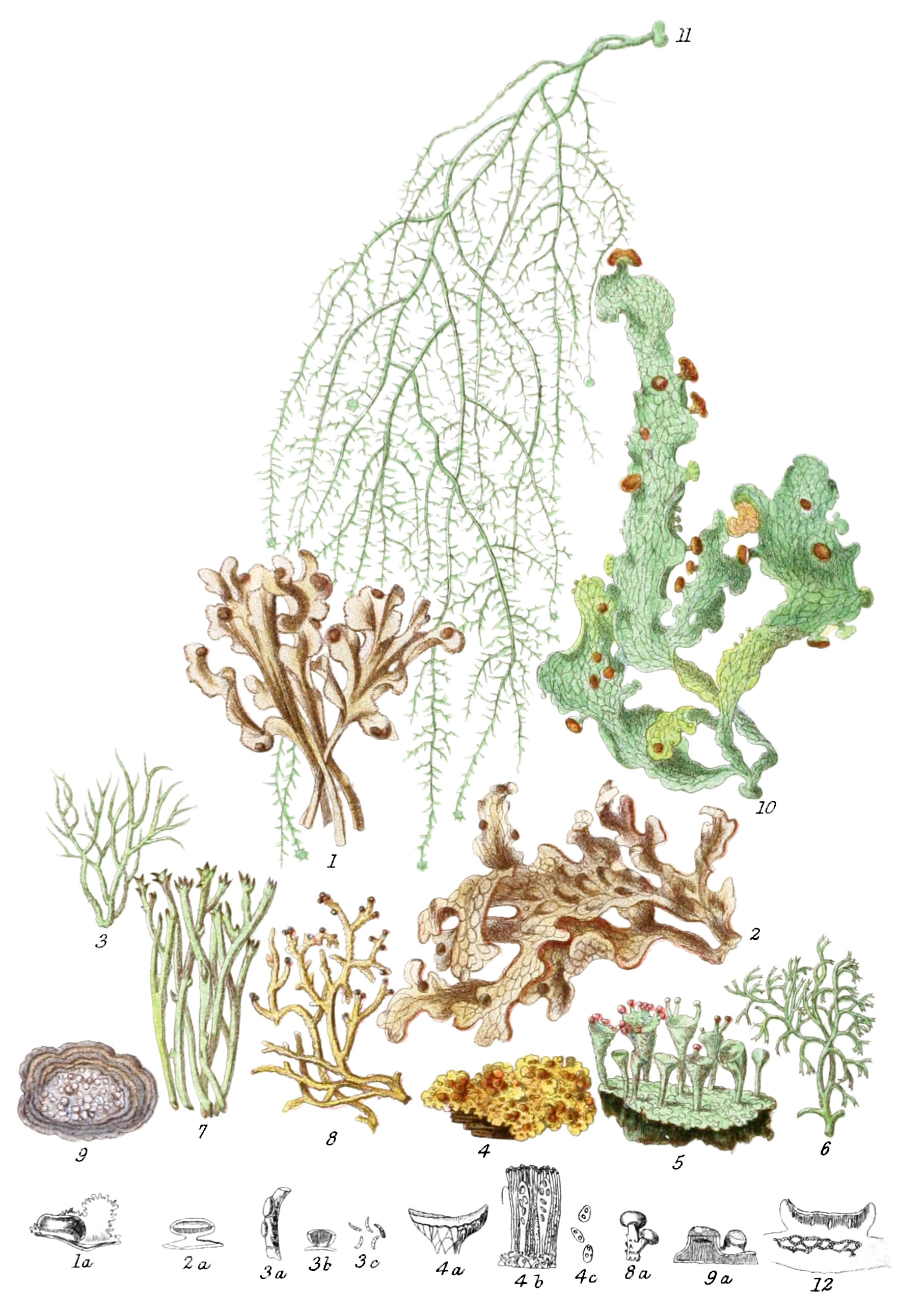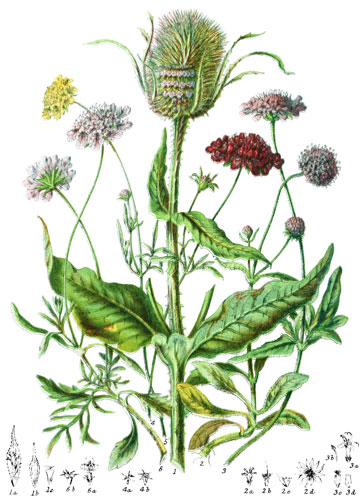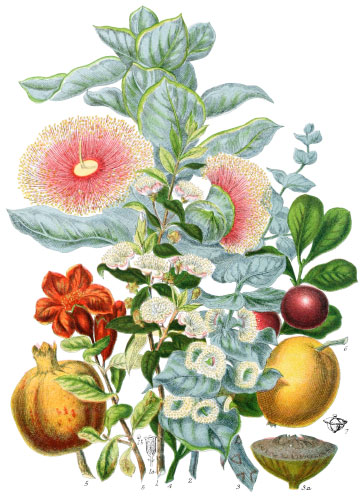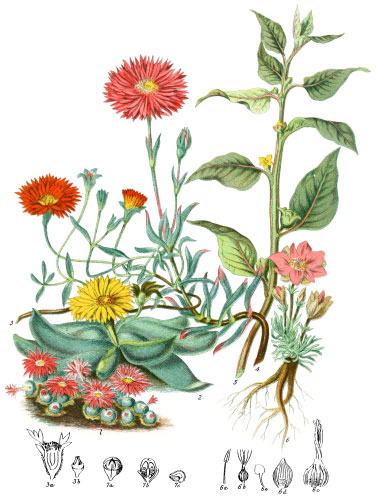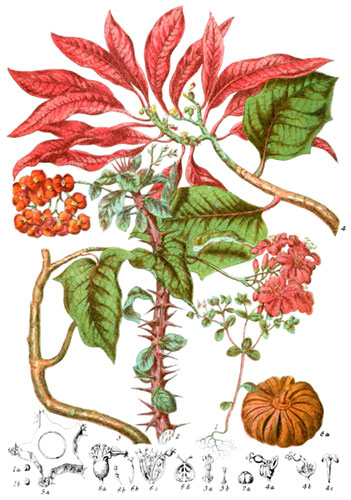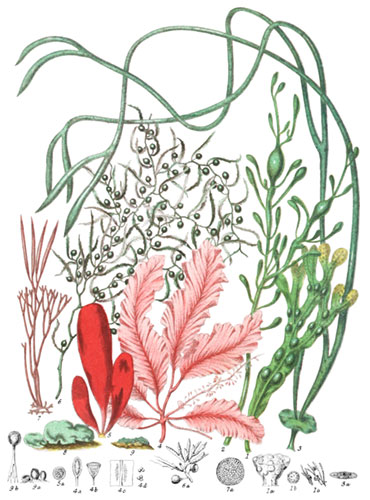Key characteristics
Perennial flowerless plants, of cellular tissue, forming a shallus, often spreading over the surface of the earth, or on rocks or trees, or usually in dry places; of a leafy or lobed form, or hard and crustaceous, or of a mealy substance. The shallus is composed of two layers, the outer one simply cellular, the inner one cellular and filamentous. In the crustaceous species the outer layer alone contains colouring matter. The reproductive organs are of two kins, either spores lying in small shields which burst the outer layers and expand on the surface, or separated green cells of the inner layer called gonidia (12), which remain beneath the outer later or break out in clusters or in cups. The plants are developed in humidity, then become a dry powdery crust out of which grow the living vegetating cells filled with reproductive matter.
This Tribe has close affinity with the sea-weed and the fungus tribes, having in many instances the growth of a sea-weed, and the fructification of a fungus.
These plants are mucilaginous and contain medicinal and nutritive properties. Lichens are the first agents of nature in the work of forming vegetable earth. The most simple powdery, almost invisible species are developed on volcanic ground and rocks, in decomposing the surface of which they add to the soil, and other lichens are thus enabled to find support for their slender roots. To these succeed mosses, and afterwards larger plants. Thus through successive years the work proceeds, till barren rocks rising out of the ocean, coral reefs, and pumice plains around volcanoes, became converted into fertile land. The old name of time-stains is admirably expressive, they are the gradual produce of time, clothing aged trees, ancient edifices and ruins, and giving the peculiar hoary aspect to some rocks. The pale hue of the granite on the coast of Cornwall at the Land’s End is entirely owing to the lichens which cover the surface.
Select plants in this order
Not all plants listed are illustrated and not all plants illustrated are listed.
- One of the most valuable of this lowly tribe as yielding nourishment to man is Cetraria islandica (1). It is found on Ben Lomond, the Pentland Hills, and other parts of Scotland, but grows more abundantly in the northern countries of Europe. On the old lava of the west coast of Iceland it finds a very suitable locality, and attains there a luxuriant growth, which has given the name to the species. By steeping in cold water it loses the bitter principle and affords an important ingredient in the sample fare of the poor Icelanders, who eat it boiled in milk, and make also a kind of meal from it for cakes. Large quantities are collected and exported under the name of Iceland moss to England and Germany, where it is considered a good remedy for consumption. It has also been employed in brewing and in making ship biscuits. In time of scarcity in Saxony the meal has been mixed with wheat flour for bread.
- Sticta (2) was so named from the Greek on account of the numerous small pits on the under surface. It is the finest of British lichens, growing always on trunks of trees; the properties are nearly similar to those of Cetraria.
- Roccella tinctoria (3) is the celebrated Portuguese orchall, yielding a find purple dye, supposed to be the same known to the ancients in the time of Dioscorides, and collected on the rocky islands of the Greek Archipelago.
- R. fructiformis abounds on the shores of Sumatra and other East Indian Isles.
- In autumn the branches of trees and stone walls in almost every part of our country, except in large cities may be seen profusely covered with Parmelia parietina (4); the golden shallus and shields contain a peculiar colouring matter called Parietin, when mixed with alum it affords a good yellow dye.
- Cenomyce pyxidata (5) is the most elegant of all our lichens, it is very frequently found on dry heaths and sandy banks, sometimes popularly called fairy cups. When the fuctification is ripe, and of a bright red, it has a remarkably pleasing effect. Several other species belong to this genus, of varied form and appearance.
- C. rangiferina (6) forms the chief food of the reindeer during the long winter in Lapland, the instinct of the animal directing him to the spots where it lies deeply covered with snow.
- C. nucialis (7) is to be seen on Scotch moors, conspicuous amongst green mosses from its silvery hue.
- Stereocaulon (8)* is the fast branching lichen that clothes the lava of extinct craters, and occupies the interstices of barren rocks.
- Ramalina (10) is an example of those which have the shield of fructification formed out of the substance of the shallus.
- In the same section is Usenea (11), well known to travellers amongst the Alps of Switzerland, having in long drooping bunches from the branches of firs, commonly called old man’s beard.
- Lecanora tartarea yields Cudbear, used in dyeing wool a pale red, it grows abundantly in Scotland, and is also imported from Norway.
- Several species of Gyrophora† are known to Canadian hunters as ripe de roche, affording them subsistence in wild districts when nothing better is to be obtained.
- The wandering tribes of Asiatic deserts eat likewise some of the mealy lichens.
The north side of trees or rocks is usually most favourable to these plants. The scorching rays of the sun parch them; they are never found on decaying matter, sometimes on evergreen leaves in the Tropics. Those which grow on the top of firs have been found to contain a large proportion of oxide and iron. Lichens have not been discovered in a fossil state.
Locations
This Tribe is scattered over the whole world, many species grow equally in various countries. The finest examples are found near the Equator, the smaller crustaceous species in the Polar regions, or on lofty mountains, scarcely discernible from the rocks to which they are attached.
Legend
- Cetraria islandica. Britain.
- Shield.
- Sticta pulmonacea. Trees, England.
- Section of Shield.
- Roccella tinctoria. Sea-coast rocks, England.
- Shields.
- Section.
- Spores.
- Parmelia parietina. Walls and trees, England.
- Shield.
- Spore-cells.
- Spores.
- Cenomyce pyxidata. Britain.
- Cenomyce rangiferina. Britain.
- Cenomyce uncialis. Britain.
- Stereocaulon paschale. Moors, Scotland.
- Fructification.
- Variolaria lactea.‡ Stone walls, England.
- Shields.
- Ramalina fraxinea. Trees, England.
- Usnea barbata. Firs, England.
- Shield with Gonidia.
- *Stereocaulon was spelled “Stereacaulon” in the original description.
- †Gyrophora was spelled “Cyrophora” in the original description.
- ‡Variolaria was spelled “Varilario” in the original description.
Explore more
Posters
Decorate your walls with colorful detailed posters based on Elizabeth Twining’s beautiful two-volume set from 1868.
Puzzles
Challenge yourself or someone else to assemble a puzzle of all 160 botanical illustrations.
